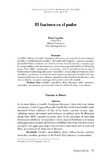Mostrar el registro sencillo del ítem
El fascismo en el poder
| dc.rights.license | http://creativecommons.org/licenses/by-nc-sa/3.0/ve/ | |
| dc.contributor.author | Capriles Arias, Elías Manuel | |
| dc.date.accessioned | 2018-01-26T15:18:23Z | |
| dc.date.available | 2018-01-26T15:18:23Z | |
| dc.date.issued | 2017-07 | |
| dc.identifier.issn | 1856-6812 | |
| dc.identifier.uri | http://www.saber.ula.ve/handle/123456789/44323 | |
| dc.description.abstract | En el libro Bolívar y Gandhi: Paradigmas libertarios, me ocupé de tres movimientos en India: (1) el liderado por Gandhi —el Partido del Congreso— que tras su muerte, Jawaharlal Nehru reorientó; (2) el de la extrema derecha fascista y casteísta, que ha comprendido varios movimientos y tiene como su partido político el Bharatiya Janata Party (BJP), actualmente en el poder, y (3) el movimiento de los que el brahmanismo había designado como “intocables”, el cual adoptó el budismo como estandarte y promueve un ideal socialista basado en principios budistas más que marxista-leninistas. En este trabajo se ahondará en los movimientos fascistas y sus raíces y aliados, en cuanto enemigos de los dalits y de la diversidad. | es_VE |
| dc.language.iso | es | es_VE |
| dc.rights | info:eu-repo/semantics/openAccess | |
| dc.subject | Gandhi | es_VE |
| dc.subject | Intocables | es_VE |
| dc.subject | Dalits | es_VE |
| dc.subject | Fascismo indio | es_VE |
| dc.subject | Casteísmo | es_VE |
| dc.subject | Ambedkar | es_VE |
| dc.subject | Musulmanes | es_VE |
| dc.subject | Partición del Indostán del British Raj | es_VE |
| dc.subject | Comunalismo | es_VE |
| dc.title | El fascismo en el poder | es_VE |
| dc.title.alternative | Fascism in Power | es_VE |
| dc.type | info:eu-repo/semantics/article | |
| dc.description.abstract1 | In the book Bolívar y Gandhi: Paradigmas libertarios, I dealt with three Indian movements: (1) the Congress Party that Gandhi led, which after Gandhi’s death Jawaharlal Nehru redefi ned; (2) that of the fascist, casteistic extreme right, including various movements and having as its political party the Bharatiya Janata Party (BJP), currently in power, and (3) the movement of those that Brahmanism labelled as “untouchables”, which adopted Buddhism as its banner and propounded a socialist ideal based on Buddhist rather than Marxist-Leninist principles. Th is paper goes deeper into the fascist movements and its roots and allies, as enemies of the dalits and of diversity. | es_VE |
| dc.description.colacion | 51-64 | es_VE |
| dc.description.email | eliascapriles@gmail.com | es_VE |
| dc.description.frecuencia | Semestral | |
| dc.identifier.depositolegal | 200602ME2418 | |
| dc.identifier.edepositolegal | 200602ME3836 | |
| dc.identifier.eissn | 2244-8810 | |
| dc.publisher.pais | Venezuela | es_VE |
| dc.subject.centroinvestigacion | Centro de Estudios de África, Asia y Diásporas Latinoamericanas y Caribeñas José Manuel Briceño Monzillo (CEAA) | |
| dc.subject.facultad | Facultad de Humanidades y Educación | es_VE |
| dc.subject.keywords | Gandhi | es_VE |
| dc.subject.keywords | Untouchables | es_VE |
| dc.subject.keywords | Dalits | es_VE |
| dc.subject.keywords | Indian fascism | es_VE |
| dc.subject.keywords | Casteism | es_VE |
| dc.subject.keywords | Ambedkar | es_VE |
| dc.subject.keywords | Muslims | es_VE |
| dc.subject.keywords | Partition of the British Raj’s Indostan | es_VE |
| dc.subject.keywords | Communalism | es_VE |
| dc.subject.publicacionelectronica | Revista Humania del Sur | |
| dc.subject.seccion | Revista Humania del Sur: | es_VE |
| dc.subject.thematiccategory | Artes y Humanidades | es_VE |
| dc.subject.tipo | Revistas | es_VE |
| dc.type.media | Texto | es_VE |
Ficheros en el ítem
Este ítem aparece en la(s) siguiente(s) colección(ones)
-
Humania del Sur - Año 012, No. 023
Julio - Diciembre 2017


